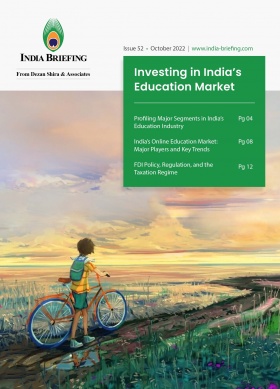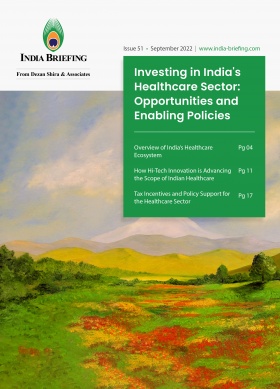Uttar Pradesh’s New Industrial Policy 2022: North Indian State Seeks to Pull in More FDI
Uttar Pradesh is a leading foreign investment destination in north India, helped by its robust connectivity infrastructure, logistics, sectoral incentives, and improved ease of doing business. Now, with the launch of the UP Industrial Investment & Employment Promotion Policy 2022, the state is seeking foreign investments to the tune of INR 10 trillion (US$120 billion), with hopes to become a US$1 trillion economy. We discuss the Uttar Pradesh industrial policy’s objectives, incentives, and eligibility criteria in this article.
The north Indian state of Uttar Pradesh (UP) is set to host a Global Investors Summit (GIS) in February 2023, and is seeking foreign investments to the tune of INR 10 trillion (US$120.69 billion). So far, 52 industrial groups have confirmed their intent to invest in the state by participating in the GIS-2023.
In the run-up to GIS-2023, the UP government has also introduced several investor-friendly policy measures. These include a single window portal ‘Nivesh Mitra’, which facilitates online approvals and clearances for setting up industries or enterprises and roll-out of 25 investment-friendly industrial policies. The Nivesh Mitra portal includes an online incentives management system (OIMS), which will enable centralized processing, approval, and payment of policy incentives online.
As India’s most populous state, Uttar Pradesh offers businesses key demographic advantages – it is a large consumer market and has a diverse talent pool. Yet, factors like the state’s population size and territory administration have challenged development efforts in the state in the past. Now, the UP government appears to be doubling down on efforts to advance its industrial base, create more jobs, and become a leading investment hub in the country.
In this article, we spotlight some of the factors supporting UP’s appeal as an investment destination. One of these is the state’s newly launched Industrial Investment & Employment Promotion Policy 2022, which will act as an umbrella policy for infrastructure and industrial development in the state.
Why invest in Uttar Pradesh?
Infrastructure connectivity and logistics
In addition to hosting the largest railway network (more than 16,000 km) in the country, the state of UP is home to a considerable portion of the Western Dedicated Freight Corridor (WDFC) and Eastern Dedicated Freight Corridor (EDFC). The WDFC provides easy access to the JNPT port at Mumbai (on the western coastline). 57 percent of the EDFC passes through UP, and connects the state to Haldia Port at Kolkata (on the eastern coastline).
Both the corridors – EDFC and WDFC – intersect at Dadri (located in the prominent Gautam Buddh Nagar district) and present unique advantages in the logistics sector. Additionally, the state is also planning for the development of a Multi-Modal Logistics Hub (MMLH) and a Multi-Modal Transport Hub (MMTH).
Further, India’s first “Freight Village”, spread over 100 acres is being developed in the Varanasi district. This village will connect the export hubs of eastern UP to ports on India’s eastern coast and will serve as a transshipment hub for inbound and outbound cargo.
Overseas investor interest in UP
Recent government sources indicate that six European countries, including France, England, the Netherlands, Denmark, Belgium, and Germany, are expected to invest in UP across 18 industries. These include energy, retail, chemical, pharmaceuticals, automobile, electronics manufacturing, EV manufacturing, infrastructure, agro and food processing, textiles, defense engineering, technology, manufacturing, agriculture equipment, water management, green house technology, venture capitalist, and transport.
Major foreign companies with an existing presence in UP include Honda (Japanese automobile company), Yamaha (Japanese motorcycle company), New Holland Agriculture (US agricultural equipment and machinery company), Adobe (US software company), Cadence (US software company), Xerox (US IT and document services company), HeidelbergCement (subsidiary of HeidelbergCement Group, Germany), EXL (US global analytics and digital solutions company), Samsung (Korean electronics giant), Ingersoll Rand (US air and gas compressor manufacturing company), and STMicroelectronics N.V. or ST (European semiconductor contract manufacturing and design company).
As per media reports, several US-based fintech and information technology (IT) companies have shown recent interest in UP for its fintech and healthcare development offerings. Sanjay Govil, the founder of Infinite Computer Solutions, is set to sign an MoU with the UP government to invest over INR 5 billion (US$60.36 million) in the near future to build its IT campuses in Noida and Lucknow. Avi Basu, the founder and CEO of Wingsure, has shown keen interest in leveraging technology for the aid of farmers in UP.
How will the UP Industrial Investment & Employment Promotion Policy 2022 support global investors?
Launched in late November, the UP Industrial Investment and Employment Promotion Policy 2022 aims to make the state of Uttar Pradesh a US$1 trillion economy. The policy seeks to establish a progressive, innovative, and competitive industrial ecosystem in the state, to create jobs, and mobilize global investments.
As per the UP state government, the 2022 industrial policy will offer one of the most attractive and optimal incentive packages for investments in India.
Incentives
The UP Industrial Investment and Employment Promotion Policy 2022 gives flexibility to investors in the state by extending a one-time choice of selecting one option out of three ‘mutually-exclusive’ options: capital subsidy, net SGST (State goods and services tax) reimbursement, and top-up on incentives received under Production Linked Incentives (PLI) Scheme.
For the purpose of the disbursement of these incentives, the policy categorizes investments into four major categories based on capital investment: Large, Mega, Super-Mega, and Ultra-Mega.
|
Capital Investment-Based Project Categories – UP Industrial Investment and Employment Promotion Policy 2022 |
|
|
Categories |
Capital investment |
|
Large |
Above INR 500 million (US$6.04 million) but below INR 2 billion (US$24.16 million) |
|
Mega |
Above INR 2 billion (US$24.16 million) but below INR 5 billion (US$60.4 million) |
|
Super-Mega |
Above 5 billion (US$60.4 million) but below INR 50 billion (US$604.01 million) |
|
Ultra-Mega |
Above INR 50 billion (US$604.01 million) |
The 2022 industrial policy will focus on making improvements across five pillars:
- Horizontal
– Quality infrastructure
– Logistics efficiency
– Access to finance
– Skilled Labor - Vertical
– Focus sectors
– Sunrise sectors
– Champion services - Global value chain integration
– Import substitution
– Export promotion, research and development (R&D), innovation
– Quality and design
– MSMEs and Local industries - Investment attractiveness
– Ease of doing business
– Marketing ‘Brand Uttar Pradesh’
– Fiscal incentives - Sustainability
– Balanced regional growth
– Circular economy and environmental protection
– Employment generation
Key measures proposed under these 5 pillars
Enabling land bank creation
The UP Industrial policy 2022 will create a land bank by promoting pooling of non-agricultural, barren, and uncultivable land for industrial use. To attract industries to set up in UP, the state government will facilitate industries in getting barren Gram Samaj land and other such eligible government land on lease to industrial enterprises at one percent of the circle rate for a period up to 50 years for setting up an industrial project.
The lease can be further extended after 50 years, based on the existing government policy. The circle rate is the lowest price, or minimum price, at which the sale or transfer of a residential or commercial property can be registered before being sold or transferred.
Promoting industrial parks and clusters
- The policy aims at developing land bank and integrated manufacturing clusters along expressways and freight corridors in UP. It intends to develop sector specific parks and clusters, such as a medical device park, textile parks, toy park, food processing parks, IT Parks etc. through various models, such as public private partnerships (PPP).
Promoting private industrial parks
- The UP state government will provide the following incentives to developers of private industrial parks with an area of 20 acres or more in the Bundelkhand and Poorvanchal regions and 30 acres or more in the Madhyanchal and Paschimanchal regions:
- Capital subsidy of 25 percent of eligible fixed capital investment (except land cost) maximum up to INR 400 million (US$48.32 million) in Madhyanchal and Paschimanchal and INR 450 million (US$54.36 million) in Bundelkhand or Poorvanchal.
- Capital subsidy at 25 percent of the cost of building hostel/dormitory housing (except land cost) for workers in the industrial park. The maximum cap on this subsidy is INR 250 million (US$30.2 million).
- 100 percent exemption on stamp duty on the purchase of land by the developer.
For private industrial parks of more than 100 acres developed anywhere in UP, the state government will extend the following incentives:
- Capital subsidy of 25 percent of eligible fixed capital investment (except land cost) maximum up to INR 800 million (US$96.64 million).
- Capital subsidy at 25 percent of the cost of building hostel/dormitory housing (except land cost) for workers in the industrial park maximum up to INR 500 million (US$60.4 million).
- 100 percent exemption on stamp duty on the purchase of land by the developer.
- UP government will provide support for development of external infrastructure facility like roads and electrical infrastructure.
Fast-tack land allotment
The new industrial policy also proposes to fast-track land allotment to eligible private sector projects and industrial public sector undertaking (PSU) projects of any state or central government.
Fast-track land allotment can be availed by:
- Projects meeting the condition of ‘Super Mega and above’ category as per their detailed project report (DPR) and as defined in this industrial policy.
- The following projects meeting the condition of ‘Mega and above’ category as per their DPR and as defined in this policy:
- Projects with 100 percent foreign direct investment (FDI).
- Companies and their holding/ subsidiary companies featuring in the Fortune Global 500 in the last three consecutive years.
- Companies and their holding/ subsidiary companies featuring in the Economic Times 200 in the last three consecutive years.
- Companies and their holding/ subsidiary companies featuring in the Forbes Global-2000/ Asia best 200 companies in the last three consecutive years.
- Large or above category projects that are industrial PSUs of any state government and central government with majority government holding.
About Us
India Briefing is produced by Dezan Shira & Associates. The firm assists foreign investors throughout Asia from offices across the world, including in Delhi and Mumbai. Readers may write to india@dezshira.com for more support on doing business in in India.
We also maintain offices or have alliance partners assisting foreign investors in Indonesia, Singapore, Vietnam, Philippines, Malaysia, Thailand, Italy, Germany, and the United States, in addition to practices in Bangladesh and Russia.
- Previous Article Toy Manufacturing in India: Government Considering PLI Scheme Worth INR 35 Billion
- Next Article India Surpasses China in M&A Fees for Western Investment Banks












